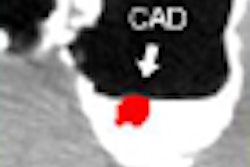
NEW YORK (Reuters Health), Aug 4 - Administration of cyclosporine at the time of percutaneous coronary intervention (PCI) for acute ST-elevation myocardial infarction (STEMI) appears to limit the size of the infarct, according to results of a small randomized trial in France.
Reperfusion after a period of myocardial ischemia is associated with increased myocardial injury, which the trial investigators attribute to mitochondrial dysfunction. Specifically, calcium overload and release of reactive oxygen species trigger the opening of the mitochondrial permeability-transition pore, resulting in metabolic abnormalities that cause cardiomyocyte death.
Cyclosporine, well known as an immunosuppressive agent, also is a potent inhibitor of mitochondrial permeability transition, and laboratory studies suggest that it can limit ischemia-reperfusion injury.
Dr. Michael Ovize at the University of Lyon and colleagues conducted a pilot study involving 58 patients who had presented within 12 hours after STEMI onset and who were about to undergo PCI. Thirty patients were assigned to treatment with a single IV bolus of cyclosporine, 2.5 mg/kg immediately before PCI, and 28 patients to receive normal saline.
According to the trial report, published in the July 31 issue of the New England Journal of Medicine, cyclosporine treatment was associated with significantly reduced release of creatine kinase (p = 0.04).
On day five, MRI scans performed in 27 patients showed significantly less infarcted tissue in cyclosporine-treated patients (median 37 g versus 46 g, p = 0.04). "This 20% reduction in the area of hyperenhancement on MRI corresponded to the 26% and 36% reductions in areas under the curve for creatine kinase and troponin I release, respectively, that were observed in this subgroup of patients," the researchers write.
Seven infarct-related adverse events in the control group and two in the cyclosporine group (p = 0.05) developed during the 48 hours after reperfusion.
These preliminary results, Ovize's team maintains, support "the argument that reperfusion necrosis is a major component of infarct size after prolonged ischemia and reperfusion, and [raise] the possibility that lethal reperfusion injury may be an important new pharmacologic target for the treatment of patients with ongoing acute myocardial infarction."
According to British editorialists Dr. Derek J. Hausenloy and Dr. Derek M. Yellon at University College London Hospitals and Medical Schools, "targeting the opening of the mitochondrial permeability-transition pore may also offer protection in other clinical contexts, such as stroke, cardiac surgery, and organ transplantation."
N Engl J Med 2008;359:473-481,518-520.
Last Updated: 2008-08-01 10:55:46 -0400 (Reuters Health)
Related Reading
Long-term adverse events with drug-eluting stents after STEMI, May 3, 2007
Copyright © 2008 Reuters Limited. All rights reserved. Republication or redistribution of Reuters content, including by framing or similar means, is expressly prohibited without the prior written consent of Reuters. Reuters shall not be liable for any errors or delays in the content, or for any actions taken in reliance thereon. Reuters and the Reuters sphere logo are registered trademarks and trademarks of the Reuters group of companies around the world.


















